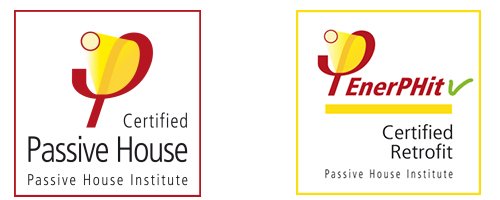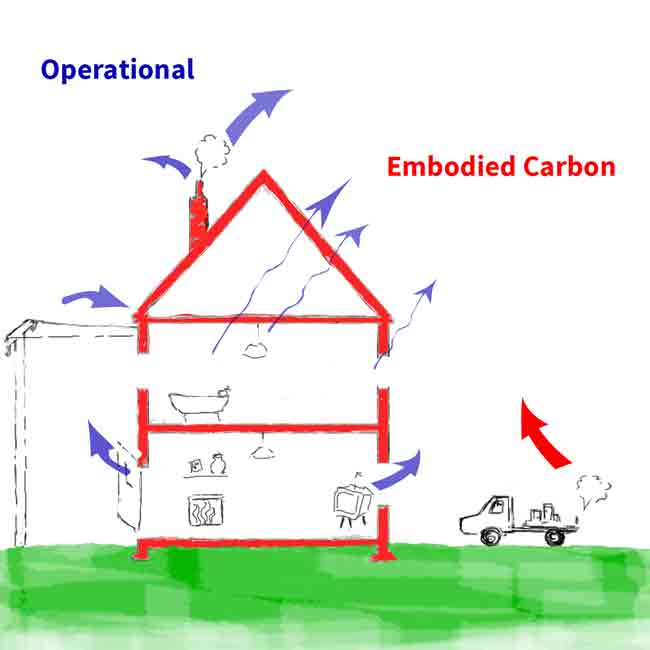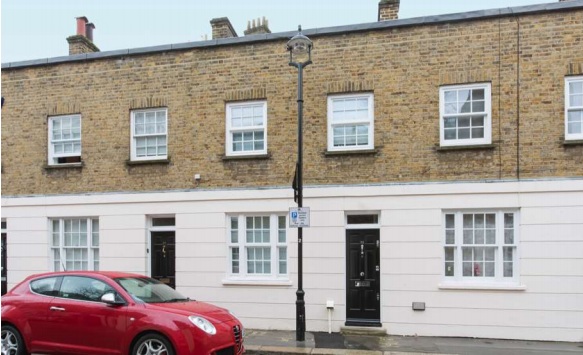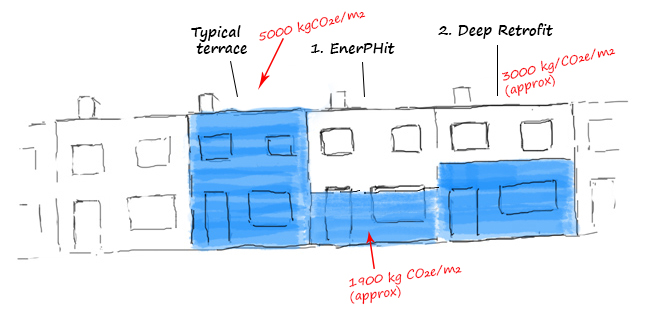Many terms are banded around when discussing energy efficiency within the housing sector. ‘Passivhaus’ and ‘EnerPHit’ Standards, together with, ‘Zero Carbon’ buildings and ‘Whole-life-carbon’ assessments, are amongst them.
The Passivhaus and EnerPHit standards include a vigorous set of rules that a building needs to conform to in order to achieve ultra low energy performance and their respective certification.
The Passivhaus certification is a set of standards designed to assess domestic properties.
 Passive House & Enerphit Logo
The EnerPHit standard is designed for existing homes where architectural and conservation issues make Passivhaus certification impossible. Both sets of standards guarantee that the building they apply to will provide the occupant with a very comfortable internal environment. These houses will also be very energy efficient and as a result will have low running costs.
A retrofit is an upgrade of a property and applied to improve both the internal environment of its inhabitants together with its energy efficiency. The term retrofit can apply to a range of building upgrades, from the installation of loft insulation to a full EnerPHit refurbishment. The term ‘deep retrofit’ is often used to refine this general term, but even this is rather vague. As the term (particularly, the deep retrofit) is often used together with EnerPHit the confusion is understandable. However, to qualify as an EnerPHit retrofit, the building must achieve EnerPHit certification.
Passivhaus new builds and EnerPHit refurbishments often feature in articles about ‘whole-life-carbon’ measurement of the building. Firstly the ‘Passivhaus’ and ‘EnerPHit’ standards are in place to achieve a very comfortable internal environment for a buildings occupant(s) and secondly to be highly energy efficient. Projects aiming for these standards may well incorporate the additional aim of achieving a positive ‘whole-life-carbon’ footprint, which can be assessed independently.
Passive House & Enerphit Logo
The EnerPHit standard is designed for existing homes where architectural and conservation issues make Passivhaus certification impossible. Both sets of standards guarantee that the building they apply to will provide the occupant with a very comfortable internal environment. These houses will also be very energy efficient and as a result will have low running costs.
A retrofit is an upgrade of a property and applied to improve both the internal environment of its inhabitants together with its energy efficiency. The term retrofit can apply to a range of building upgrades, from the installation of loft insulation to a full EnerPHit refurbishment. The term ‘deep retrofit’ is often used to refine this general term, but even this is rather vague. As the term (particularly, the deep retrofit) is often used together with EnerPHit the confusion is understandable. However, to qualify as an EnerPHit retrofit, the building must achieve EnerPHit certification.
Passivhaus new builds and EnerPHit refurbishments often feature in articles about ‘whole-life-carbon’ measurement of the building. Firstly the ‘Passivhaus’ and ‘EnerPHit’ standards are in place to achieve a very comfortable internal environment for a buildings occupant(s) and secondly to be highly energy efficient. Projects aiming for these standards may well incorporate the additional aim of achieving a positive ‘whole-life-carbon’ footprint, which can be assessed independently.
 Operational and Embodied Carbon - based on original sketch from Sturgis Carbon Profiling
The ‘whole-life- carbon’ assessment combines both the operational costs of a building together with the embedded carbon inherent in these materials. Embedded carbon refers to the carbon within construction materials including the carbon emissions used to manufacture and transport as well as replace these materials. Generally a ‘whole-life-carbon’ assessment will extrapolate the values for these two types of carbon emissions over the life-cycle of a building which is generally taken to be 60 years. There are a number of models for assessment of ‘embodied carbon’. The ‘whole-life carbon assessment’ - BS EN 15978:2011 is a standardised assessment process developed by the European Committee for Standardisation. This assessment process can be subdivided in to four distinct categories:
Operational and Embodied Carbon - based on original sketch from Sturgis Carbon Profiling
The ‘whole-life- carbon’ assessment combines both the operational costs of a building together with the embedded carbon inherent in these materials. Embedded carbon refers to the carbon within construction materials including the carbon emissions used to manufacture and transport as well as replace these materials. Generally a ‘whole-life-carbon’ assessment will extrapolate the values for these two types of carbon emissions over the life-cycle of a building which is generally taken to be 60 years. There are a number of models for assessment of ‘embodied carbon’. The ‘whole-life carbon assessment’ - BS EN 15978:2011 is a standardised assessment process developed by the European Committee for Standardisation. This assessment process can be subdivided in to four distinct categories:
 11 & 19 Passmore Street, London (image courtesy of: Sturgis Carbon Profiling)
These properties provided a perfect opportunity to compare the effect of two types of retrofits in identical houses. No 11 and 19 Passmore Street had improvements to EnerPHit certification levels, whereas No 23 received a typical standard refurbishment. This project also benefitted from being able to compare the two types of retrofit with an identical, unimproved dwelling.
No 23 Passmore Street was improved by the addition of:
11 & 19 Passmore Street, London (image courtesy of: Sturgis Carbon Profiling)
These properties provided a perfect opportunity to compare the effect of two types of retrofits in identical houses. No 11 and 19 Passmore Street had improvements to EnerPHit certification levels, whereas No 23 received a typical standard refurbishment. This project also benefitted from being able to compare the two types of retrofit with an identical, unimproved dwelling.
No 23 Passmore Street was improved by the addition of:
 Numbers taken from Whole life cycle assessment graph on retrofit scenarios, Sturgis Carbon Profiling
The two pilot EnerPHits combined, achieved an estimated saving of 840,000 kg CO2 equivalent to the weight of 185 elephants over the buildings life (60 years).
These dramatic figures do not reflect the impact such retrofits have on the occupants. Sturgis Carbon Profiling have been compiling data on the effect such improvements have on the lives of their occupants. This gives rise to yet another measurement category, the ‘wellbeing’ measurements. This area of retrofits and their repercussions is still evolving.
Numbers taken from Whole life cycle assessment graph on retrofit scenarios, Sturgis Carbon Profiling
The two pilot EnerPHits combined, achieved an estimated saving of 840,000 kg CO2 equivalent to the weight of 185 elephants over the buildings life (60 years).
These dramatic figures do not reflect the impact such retrofits have on the occupants. Sturgis Carbon Profiling have been compiling data on the effect such improvements have on the lives of their occupants. This gives rise to yet another measurement category, the ‘wellbeing’ measurements. This area of retrofits and their repercussions is still evolving.
 Passive House & Enerphit Logo
The EnerPHit standard is designed for existing homes where architectural and conservation issues make Passivhaus certification impossible. Both sets of standards guarantee that the building they apply to will provide the occupant with a very comfortable internal environment. These houses will also be very energy efficient and as a result will have low running costs.
A retrofit is an upgrade of a property and applied to improve both the internal environment of its inhabitants together with its energy efficiency. The term retrofit can apply to a range of building upgrades, from the installation of loft insulation to a full EnerPHit refurbishment. The term ‘deep retrofit’ is often used to refine this general term, but even this is rather vague. As the term (particularly, the deep retrofit) is often used together with EnerPHit the confusion is understandable. However, to qualify as an EnerPHit retrofit, the building must achieve EnerPHit certification.
Passivhaus new builds and EnerPHit refurbishments often feature in articles about ‘whole-life-carbon’ measurement of the building. Firstly the ‘Passivhaus’ and ‘EnerPHit’ standards are in place to achieve a very comfortable internal environment for a buildings occupant(s) and secondly to be highly energy efficient. Projects aiming for these standards may well incorporate the additional aim of achieving a positive ‘whole-life-carbon’ footprint, which can be assessed independently.
Passive House & Enerphit Logo
The EnerPHit standard is designed for existing homes where architectural and conservation issues make Passivhaus certification impossible. Both sets of standards guarantee that the building they apply to will provide the occupant with a very comfortable internal environment. These houses will also be very energy efficient and as a result will have low running costs.
A retrofit is an upgrade of a property and applied to improve both the internal environment of its inhabitants together with its energy efficiency. The term retrofit can apply to a range of building upgrades, from the installation of loft insulation to a full EnerPHit refurbishment. The term ‘deep retrofit’ is often used to refine this general term, but even this is rather vague. As the term (particularly, the deep retrofit) is often used together with EnerPHit the confusion is understandable. However, to qualify as an EnerPHit retrofit, the building must achieve EnerPHit certification.
Passivhaus new builds and EnerPHit refurbishments often feature in articles about ‘whole-life-carbon’ measurement of the building. Firstly the ‘Passivhaus’ and ‘EnerPHit’ standards are in place to achieve a very comfortable internal environment for a buildings occupant(s) and secondly to be highly energy efficient. Projects aiming for these standards may well incorporate the additional aim of achieving a positive ‘whole-life-carbon’ footprint, which can be assessed independently.
 Operational and Embodied Carbon - based on original sketch from Sturgis Carbon Profiling
The ‘whole-life- carbon’ assessment combines both the operational costs of a building together with the embedded carbon inherent in these materials. Embedded carbon refers to the carbon within construction materials including the carbon emissions used to manufacture and transport as well as replace these materials. Generally a ‘whole-life-carbon’ assessment will extrapolate the values for these two types of carbon emissions over the life-cycle of a building which is generally taken to be 60 years. There are a number of models for assessment of ‘embodied carbon’. The ‘whole-life carbon assessment’ - BS EN 15978:2011 is a standardised assessment process developed by the European Committee for Standardisation. This assessment process can be subdivided in to four distinct categories:
Operational and Embodied Carbon - based on original sketch from Sturgis Carbon Profiling
The ‘whole-life- carbon’ assessment combines both the operational costs of a building together with the embedded carbon inherent in these materials. Embedded carbon refers to the carbon within construction materials including the carbon emissions used to manufacture and transport as well as replace these materials. Generally a ‘whole-life-carbon’ assessment will extrapolate the values for these two types of carbon emissions over the life-cycle of a building which is generally taken to be 60 years. There are a number of models for assessment of ‘embodied carbon’. The ‘whole-life carbon assessment’ - BS EN 15978:2011 is a standardised assessment process developed by the European Committee for Standardisation. This assessment process can be subdivided in to four distinct categories:
- (Part 1) Encompasses the extraction of raw materials and processing
- (Part 2) Transport and assemblage of construction materials
- (Part 3) Maintenance and energy usage
- (Part 4) Estimation of the carbon costs of deconstruction, including transportation and disposal.
 11 & 19 Passmore Street, London (image courtesy of: Sturgis Carbon Profiling)
These properties provided a perfect opportunity to compare the effect of two types of retrofits in identical houses. No 11 and 19 Passmore Street had improvements to EnerPHit certification levels, whereas No 23 received a typical standard refurbishment. This project also benefitted from being able to compare the two types of retrofit with an identical, unimproved dwelling.
No 23 Passmore Street was improved by the addition of:
11 & 19 Passmore Street, London (image courtesy of: Sturgis Carbon Profiling)
These properties provided a perfect opportunity to compare the effect of two types of retrofits in identical houses. No 11 and 19 Passmore Street had improvements to EnerPHit certification levels, whereas No 23 received a typical standard refurbishment. This project also benefitted from being able to compare the two types of retrofit with an identical, unimproved dwelling.
No 23 Passmore Street was improved by the addition of:
- Double glazing
- Roof insulation
- Rear wall and internal front wall insulation
- the EnerPHit refurbishment reduced the ‘Whole-life –carbon’ emissions by 60 - 65%
- the operational emissions were reduced by 75%
- the Deep Retrofit reduced the ‘Whole-life-carbon’ emissions by 30%
 Numbers taken from Whole life cycle assessment graph on retrofit scenarios, Sturgis Carbon Profiling
The two pilot EnerPHits combined, achieved an estimated saving of 840,000 kg CO2 equivalent to the weight of 185 elephants over the buildings life (60 years).
These dramatic figures do not reflect the impact such retrofits have on the occupants. Sturgis Carbon Profiling have been compiling data on the effect such improvements have on the lives of their occupants. This gives rise to yet another measurement category, the ‘wellbeing’ measurements. This area of retrofits and their repercussions is still evolving.
Numbers taken from Whole life cycle assessment graph on retrofit scenarios, Sturgis Carbon Profiling
The two pilot EnerPHits combined, achieved an estimated saving of 840,000 kg CO2 equivalent to the weight of 185 elephants over the buildings life (60 years).
These dramatic figures do not reflect the impact such retrofits have on the occupants. Sturgis Carbon Profiling have been compiling data on the effect such improvements have on the lives of their occupants. This gives rise to yet another measurement category, the ‘wellbeing’ measurements. This area of retrofits and their repercussions is still evolving. - Date
- Category
- The Built Environment